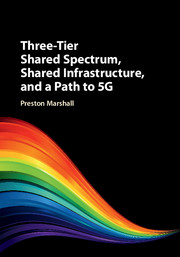Book contents
- Frontmatter
- Contents
- Acknowledgments
- Preface
- Part I Spectrum Sharing Background
- Part II Three-Tier Dynamic Spectrum Models
- 3 Key Aspects of PCAST Recommendations
- 4 US FCC CBRS Regulations, and Other International Activity
- Part III Components of a Three-Tier Architecture
- Part IV Protection Processes for Incumbents and Peers
- Part V Example Use of Three-Tier Spectrum: Use of the 3.5 GHz CBRS Band in the USA
- Part VI Future Bands, Network Services, Business Models, and Technology
- Part VII Appendices
- Index
- References
3 - Key Aspects of PCAST Recommendations
from Part II - Three-Tier Dynamic Spectrum Models
Published online by Cambridge University Press: 30 August 2017
- Frontmatter
- Contents
- Acknowledgments
- Preface
- Part I Spectrum Sharing Background
- Part II Three-Tier Dynamic Spectrum Models
- 3 Key Aspects of PCAST Recommendations
- 4 US FCC CBRS Regulations, and Other International Activity
- Part III Components of a Three-Tier Architecture
- Part IV Protection Processes for Incumbents and Peers
- Part V Example Use of Three-Tier Spectrum: Use of the 3.5 GHz CBRS Band in the USA
- Part VI Future Bands, Network Services, Business Models, and Technology
- Part VII Appendices
- Index
- References
Summary
Movement Towards Flexible, Dynamic Spectrum Policies
The United States (US) President's Council of Advisors on Science and Technology (PCAST) is a US policy advisory board that directly advises the President and his Executive Office, with recommendations in science, technology and innovation. It comprises leading scientists and engineers, and performs a number of studies each year in a variety of topics selected by the committee. In 2011–2012, PCAST performed a study on Federal spectrum policy and innovation, which was released in July, 2012 [1]. This report provided a broad framework for managing shared spectrum, as well as specific recommendations for immediate policy initiatives to implement its recommendations in Federal-controlled spectrum. The broad framework was a fundamental departure from many of the approaches that had dominated spectrum policy.
The PCAST report did not spring up arbitrarily, or suddenly. It was the product of several prior evolutions of spectrum policy thinking in the United States of America (USA), and worldwide. Some of the prior efforts that set the stage for the development and acceptance of the PCAST recommendations include those shown in Table 3.1. There will likely be further extensions and enhancements to the PCAST three-tier model that will emerge, but it is an important starting point, and worth close examination.
This book utilizes much of the PCAST report as a baseline for the three-tier concept. However, the PCAST report is far from perfect. In part, the report is a political document, formed through compromise and consensus-building; reflecting not only technical realities, but political, and economic ones as well. Therefore, this concept of three-tier in this book is heavily influenced by PCAST, but is not identical. It reflects a further four years of industrial development, regulatory litigation, and the participation of innumerably more insights, perspectives, and points of view, than were reflected in the initial report.
PCAST Findings and Recommendations
A summary of significant findings of the PCAST report [1] are included in a single table in the report. This table outlines seven finding areas, and their associated recommendations. Some are specific to the US spectrum management and policies, but most are inherently technical, and not nationally specific. These findings of the PCAST report are summarized (abridged) in Table 3.2. Although these findings were focused on US economic considerations, they are likely similar to many developed economies.
- Type
- Chapter
- Information
- Publisher: Cambridge University PressPrint publication year: 2017
References
- 1
- Cited by



